All this leads us to think that it
is the non-assimilated form that is becoming the prestige form once again for school-age
speakers, since it is the form reflected by the spelling, the spoken norm used by all the
media in Catalan, the form used by those teachers who are not from the area, and of
course, the form that coincides with Spanish.
2.3
Maintenance or otherwise of open vowels
The traditional
language model of the county of Baix Vinalopó uses open /o/ and /e/ in the normal way. It
is only the most recent generations that are beginning to show a change in this respect.
Figure 8 shows this in the case of the open /o/ phoneme:
Some 10% of the
young adults between 18 and 36 throughout the county show the Spanish inspired/ tendency  > [o] that we refer to here.
Distribution is not uniform across the county: > [o] that we refer to here.
Distribution is not uniform across the county:  preservation of the distinction, generally speaking, is strongest where Catalan has most
vitality.
preservation of the distinction, generally speaking, is strongest where Catalan has most
vitality.
The factor Eval
seems not to influence this trend (see figure 9) and this is a first instance in which
such a contradiction is evident in our data. Our expectation was that Eval (education
in Catalan) would not be associated with elimination of normative or standard forms, or
that this factor could cause them to be reintroduced if they had a tendency to be lost.
This contradiction has to do with the fact, above all, of the particular linguistic
behaviour of the school age speakers of Elx. In Crevillent, on the other hand, where
Catalan has great vitality, the Eval factor is weakly associated with
maintenance of the open v. closed distinction. Lastly, at Santa Pola the education
programme there is not proving effective in recovering the distinction between open and
closed, since the pronunciation has gone to  ; here
the completion of the sound change is impeding the return to the distinction, for the
moment. ; here
the completion of the sound change is impeding the return to the distinction, for the
moment.
Figure 8. Percentage by age of
open o: dorm (sleeps) |
|
Figure 9. Percentage by school
syllabus of open o: dorm (sleeps) |
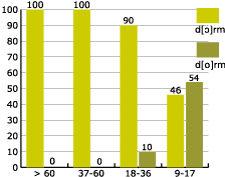 |
|
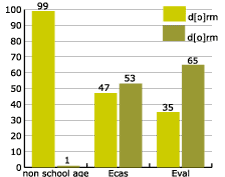 |
2.4 Yeism
Yeism
is not a feature of the pronunciation in this county, yet it has made rapid progress. This
is one of the most striking developments. Among the elders, only 16% of the age group
across the county have Yeism, while among school students the sound [ ] scarcely exists. What is more, the gap between the
elders and the adults is very marked —58 %— the transition between the two
younger generations is a mere 8 %. (See figure 10.) ] scarcely exists. What is more, the gap between the
elders and the adults is very marked —58 %— the transition between the two
younger generations is a mere 8 %. (See figure 10.)
Figure
10. Percentage by age of realisations of ll: cavall (horse)
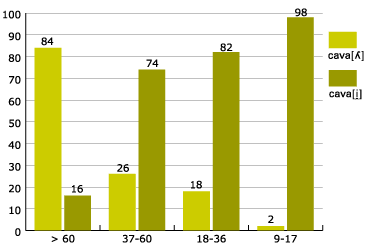
There is no
notable relation between education syllabus and the preservation of the phonetic
distinction under consideration here, given that Yeism is absolutely categorical
among school students. What we have here, then, is clearly a generational change that
cannot be stopped by Eval.
2.5 Palatalisation of the implosive before [k]
In the Baix
Vinalopó, the traditional pronunciation for palatal sibilants  is found only among the elders and to some extent the adults
(see figure 11). Selection of the form falls sharply among the young adults and is reduced
to a mere 14% among the school-aged, replaced basically by the general Catalan form and
coinciding with the Spanish pronunciation for mosca ("fly") which
supplied more than 60% of the replies. is found only among the elders and to some extent the adults
(see figure 11). Selection of the form falls sharply among the young adults and is reduced
to a mere 14% among the school-aged, replaced basically by the general Catalan form and
coinciding with the Spanish pronunciation for mosca ("fly") which
supplied more than 60% of the replies.
Figure
11. Percentage by age of implosive s followed by [k]: mosca (fly)
![percentage by age of implosive s followed by [k]](grafics_%20segura/a_grafic11_segura.gif)
In this instance
too, the traditional form is in sharp decline. The two factors most likely to be invoked
here, standard Catalan and Spanish, provide support for this change. Additionally, there
is a quite vigorous innovation, mo[h]ca, evidently having its source in
Spanish, and clearly linked to the fronterizo Spanish of the Baix Segura and
Murcia. This incipient innovation is heard occasionally among the adults but more habitual
among the school-aged of Guardamar and Elx. The Spanish media are similarly a factor
reinforcing this realisation.
As can be seen in
figure 12, Eval subjects quite frequently give the Spanish-influenced reply [h]ca
—around 20% of the total number of replies —a frequency which compares with the
level evinced by the Lval group, though the latter produce slightly more. The
reason for this is that the phenomenon is more usual in areas of heavy Spanish influence,
and for that reason frequently elicited for the Eval respondents in Elx. The
school-age speakers in Crevillent and Santa Pola have not advanced far with this change.
Figure
12. Percentage by syllabus of implosive s followed by [k]: mosca (fly)
![percentage by syllabus of implosive s followed by [k]](grafics_%20segura/a_grafic12_segura.gif)
On the other hand,
the traditional form mo[ ]ka is still
present in the speech of school children in the Lval category, occurring 47%
of the time), while it has all but disappeared among Eval pupils in favour
of standard mosca. ]ka is still
present in the speech of school children in the Lval category, occurring 47%
of the time), while it has all but disappeared among Eval pupils in favour
of standard mosca.
2.6 The s in syntactic phonetics
The only
traditional and current model for the county (with the single exception of Guardamar) is
that which you find in practically all Catalan speech: the voicing of –s
before a vowel (see figure 13). The advance of a voiceless variant and the retreating of
the traditional voiced sibilant is generational: while there is no sign of the change from
[z] > [s] in the two oldest age groups, half the young adults produce it and two thirds
of the school-agers. As figure 14 shows there are no relevant differences according to the
medium of education.
Figure 13. Percentage by age
voiced s in syntactic phonetics: dos amics (two friends) |
|
Figure 14. Percentage by
syllabus of voiced s in syntactic phonetics: dos amics (two friends) |
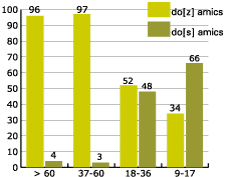 |
|
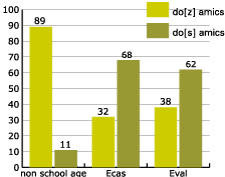 |
2.7 The -ix group
In intervocalic
position the variant without the semi-vowel is overwhelmingly the preferred form  throughout the county and for all the adult generations.
This can be observed in figure 15. It is only among the school-age speakers that there any
appreciable occurrences —at 22%— of the semi-vowel form, occurring mostly with Eval
subjects (see figure 16). throughout the county and for all the adult generations.
This can be observed in figure 15. It is only among the school-age speakers that there any
appreciable occurrences —at 22%— of the semi-vowel form, occurring mostly with Eval
subjects (see figure 16).
Figure 15. Percentage by ages of
realisation of semi-vowel in group ix: caixa (box; savings bank) |
|
Figure 16. Percentage by school
syllabus of realisation of semi-vowel in the group ix: caixa (box;
savings bank) |
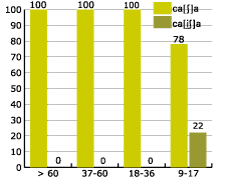 |
|
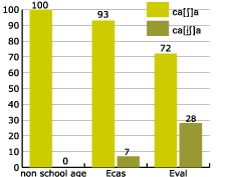 |
2.8 Betacism
Betacism
was something totally alien to the everyday speech of the county, until comparatively
recently. The influx of Spanish, historically associated with betacism, has started to
have real impact in recent years.
Our study detected
more than 30% with betacism, distributed with gradual increase over the generations (see
figure 17): with schoolchildren it reaches 62%. It affects all areas in a similar way,
although again it is less prevalent in the conservative rural areas and more usual in the
coastal areas and in Elx.
The Eval group
(see figure 18) once again show a slightly more Spanish-affected pattern, as we have seen
several times before. The Lval group distinguish the two sounds rather more frequently. We
note that in Santa Pola, betacism has become categorical and the Eval factor shows no
corrective influence. At Crevillent, Eval subjects are considerably less betacist than the
rest, and this, as we have seen before, is the expected pattern. In Elx, however, betacism
is more prevalent among the Eval group and adds to the overall effect that the Eval
results are not the expected ones. We return to this question in section 2.14 where we
attempt to explain this development. |
